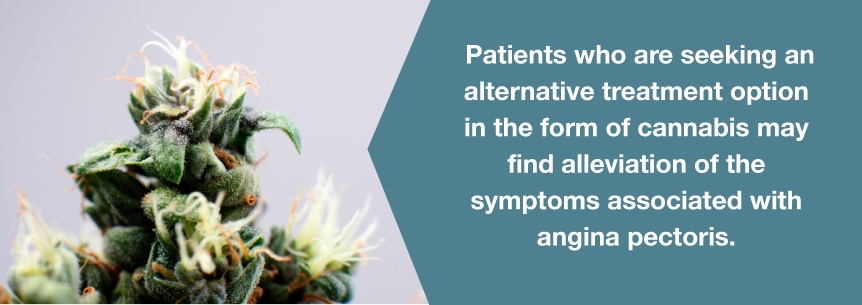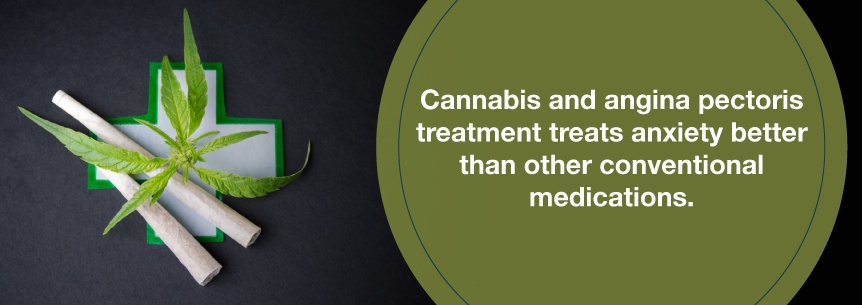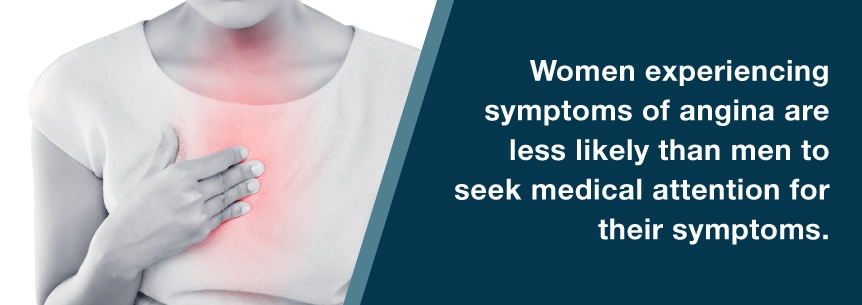The cannabis plant contains various psychoactive components, including tetrahydrocannabinol (THC), its primary psychoactive compound. Another common compound in the plant is cannabidiol (CBD), which is gaining more popularity these days due to its valuable therapeutic properties. Researchers are now studying medical marijuana for angina pectoris for its ability to treat pain, anxiety, fatigue, nausea and other symptoms related to the condition.
If your physician diagnosed you with stable angina, the more you know about the condition and its treatment, the better prepared you will be to improve your quality of life while living with it.
Some individuals using medical cannabis could experience less severity in their symptoms of angina pectoris because of the increased blood flow to the area. However, cannabis could have potential to worsen the condition. Therefore, when suffering from angina pectoris, you should consult your doctor first before starting medical weed.
There have been several studies showing the therapeutic benefits of marijuana for angina pectoris. For instance, researchers conducted a recent study in Israel to study what heart protection small doses of THC provided.
They administered small doses of THC in mice before they restricted their blood flow to simulate a heart attack. In reference to the “heart attack,” they administered the THC on three different schedules — two hours before, 48 hours before and three weeks before continuous treatment. To gauge THC’s effect during the study, the researchers looked for certain residual effects or common signs of heart attacks. They noted THC administration in each schedule showed improvement.
A healthy heart no doubt leads to a longer lifespan. The research above indicates THC at very low doses may be beneficial in cardiac surgery preparation, limiting the damage the individual incurs and potentially helping in their recovery.
Find A Doctor Find A Dispensary
Although there is a weak relationship between the severity of pain and degree of oxygen deprivation associated in the heart muscle, angina pectoris can be an extremely serious condition that can result in death if not treated properly. Patients who are seeking an alternative treatment option in the form of cannabis may find alleviation of the symptoms associated with angina pectoris.

Cannabinoids have had a distinct effect on the body for those who suffer from cardiac complications. Patients suffering from angina pectoris may experience increased blood flow and a slight decrease in heart rate after using medical marijuana. Tolerance to the cardiovascular effects of cannabis on the heart develops within seven to 10 days of marijuana use.
Cannabis for angina pectoris treatment can help with various symptoms of the condition, including the following:
For centuries, people have been using medical pot medicinally all over the world, for chronic pain and other ailments. As countries and states implement policies for recreational and medical weed, more and more people are beginning to use the herb for pain.
Cannabis and angina pectoris treatment is a much safer option than opioids, which can result in dependency and addiction. Recent research is showing evidence medical cannabis is leading to a potential reduction in opioid pain management due to more people implementing medical marijuana regimens.
Marijuana and angina pectoris treatment is a great alternative to conventional nonspecific treatments for fatigue, since it works with your body’s natural chemicals to regulate your energy levels. Certain marijuana strains are made specifically for tackling fatigue. The cannabinoids in these specific strains typically have higher CBD concentration known to energize. When looking at strains to combat your fatigue, understand Sativa strains provide more energy than Indica strains.
Nausea and vomiting can interfere with daily living tasks. Researchers studied how cannabinoids affect nausea. In one particular study in 1975, researchers found all 20 of their study participants experienced relief from their nausea after using THC. Recent studies show the cannabinoid CBD offers antiemetic potential.
Cannabis and angina pectoris treatment treats anxiety better than other conventional medications. Cannabis starts relieving symptoms almost instantly, doesn’t produce unwanted side effects and is useful in reducing anxiety in acute circumstances.

CBD provides relief from anxiety symptoms like worry, acute stress and fear. In one Brazilian study, researchers found after taking CBD, patients reported a significant reduction in their anxiety. The researchers didn’t just take the patients’ word for it, either. They took brain scans showing an anti-anxiety effect in the patients’ cerebral blood circulation patterns.
Here are some effective medical marijuana and angina pectoris strains to try.
One of the best strains to try to relieve many of your angina pectoris symptoms is Green Haze, a Sativa that helps treat pain, fatigue, depression, nausea, stress and lack of appetite.
When getting started with medical cannabis for angina pectoris, you have a lot of options available for how you’re going to consume the medical herb. Smoking may be the fastest method of feeling marijuana’s effects. However, there is some question as to whether it can be harmful to your lungs.
Therefore, you may wish to consider healthier consumption methods such as the ones below, which may be better options for you.
It’s a personal decision which method you prefer to use and which one provides you with the most therapeutic benefits. You may need to try out a few different methods first to find the right one.
For more information on cannabis and angina pectoris treatment and to see how the herb can relieve your symptoms, book an appointment with a medical marijuana doctor in your state. You’ll also find information on state laws, cannabis products, a list of dispensaries and much more on our extensive website.
Find A Doctor Find A Dispensary
Angina pectoris is a heart condition commonly called stable angina. According to MD News, a clinical news magazine for physicians, there are approximately 500,000 new cases of angina pectoris diagnosed each year. And there are nearly 10 million people currently living with angina.
Angina occurs when your heart doesn’t get sufficient oxygen and must work harder to perform its functions for your body. Most often, this is a result of plaque buildups in your arteries from coronary artery disease.
Stable angina is the most common form of angina. It isn’t a heart attack, but having it may indicate a greater risk of having one. The American Heart Association describes angina pectoris as a medical term for the chest pain or discomfort you feel as a result of coronary heart disease. The pain occurs because your heart muscle isn’t getting the amount of blood it needs.
Angina pectoris often presents as an uncomfortable fullness in the chest. Some people describe the pain as pressure or a squeezing sensation. In addition to the chest pain, you may also experience pain in one or more of the following locations:
Many people mistake the chest pain of angina from other types of chest pain, including indigestion. However, if you experience chest pain that you cannot explain you should seek medical attention immediately.

While angina pectoris itself is a symptom of coronary heart disease, rather than a condition on its own, there are certain signs commonly associated with it, including:
Some people indicate the pain from angina pectoris is difficult to locate or specifically identify.
If you have one of the following, you have a greater risk of developing stable angina, according to the Mayo Clinic:
Physical exertion, such as the below activities, can trigger stable angina episodes:
During these activities, your heart demands more blood, but your body is unable to accommodate the increased demand.
The National Heart, Lung and Blood Institute reports the following may also trigger your angina:
While you can’t avoid all physical activities for the rest of your life in hopes of preventing these types of attacks, you can take precautions, especially if you’re at an elevated risk of developing angina pectoris.

To diagnose angina pectoris, doctors order a panel of tests including:
These tests, of course, are in addition to observations, family histories and confirmation of risk factors.
While there are multiple types of angina, other than angina pectoris, two main forms of stable angina exist.
Because physical exertion can trigger the chest pressure, fullness and pain of angina pectoris, your physician may ask you to limit the amount of heavy activity you have in your day or recommend changes in routine or lifestyle to prevent angina.
Since angina is a symptom of a much larger health risk, your doctor may have very specific suggestions for physical activities to limit the frequency of your stable angina episodes, so you experience fewer instances.
Angina pectoris is a symptom of a disease leading to much greater cause for concern. Chronic illnesses take enormous emotional and mental tolls — sometimes larger than their physical impacts.
If you feel you may be suffering from anxiety or depression related to your condition, be sure to discuss your concerns with your physician to seek constructive solutions together.
Despite some of the statistics below, treatments can extend your mortality by years even after your doctor diagnosed you with angina pectoris.
The primary treatments for angina pectoris involve the following.
This includes things like:
The side effect of all these activities is better health for you. Some people are encouraged to engage in preventive treatments for angina pectoris.
Daily aspirin regimens may thin the blood so it flows through narrowed arteries more effectively.
The downside of using aspirin to thin the blood is that it allows you to bleed more easily and may aggravate your stomach.
Statin medications are also prescribed to reduce cholesterol in the blood while increasing the supply of high-density lipoproteins in the blood.
Statin may have side effects that include:
Your physician may prescribe a variety of medications to treat angina, including:
Sometimes, medications alone are not enough. When this occurs, more invasive interventions become necessary, like coronary angioplasty, where a doctor inserts a balloon into the veins and inflates it. Once the inflation occurs, physicians may or may not decide to place a stent to hold the artery open.
Another possibility involves coronary artery bypass grafting, in which a surgeon grafts donor blood vessels from other sites in the body onto the blocked coronary artery, providing a new path for oxygen-rich blood to flow into the heart.
One of the new developments physicians in South Korea are currently investigating is the viability of an angina pectoris treatment called spinal cord stimulation. It’s a minimally invasive procedure implanting an electrode in the epidural space to stimulate the spinal cord.